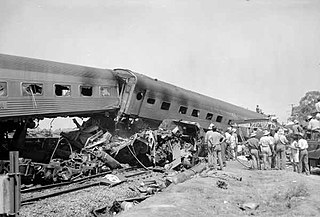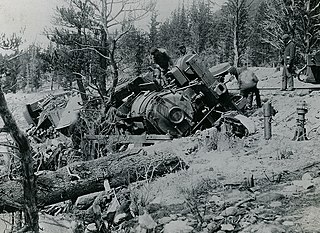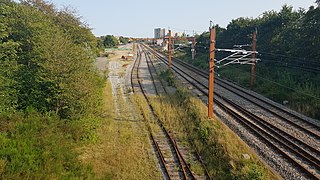
The TGV is France's intercity high-speed rail service. With commercial operating speeds of up to 320 km/h (200 mph) on the newer lines, the TGV was conceived at the same period as other technological projects such as the Ariane 1 rocket and Concorde supersonic airliner; sponsored by the Government of France, those funding programmes were known as champion national policies. In 2023 the TGV network in France carried 122 million passengers.

The Violet Town rail accident, also known as the Southern Aurora disaster, was a railway accident that occurred on 7 February 1969 following the incapacitation of the driver of one of the trains, near the McDiarmids Road crossing, approximately 1 km south of Violet Town, Victoria, Australia. The crash resulted in nine deaths and 117 injuries.

In rail transport, a derailment is a type of train wreck that occurs when a rail vehicle such as a train comes off its rails. Although many derailments are minor, all result in temporary disruption of the proper operation of the railway system and they are a potentially serious hazard.

The town of Morpeth in Northumberland, England, has what is reputed to be the tightest curve of any main railway line in Britain. The track turns approximately 98° from a northwesterly to an easterly direction immediately west of Morpeth Station on an otherwise fast section of the East Coast Main Line railway. This was a major factor in three serious derailments between 1969 and 1994. The curve has a permanent speed restriction of 50 miles per hour (80 km/h).
The Sutton Coldfield train crash took place at about 16:13 on 23 January 1955 in Sutton Coldfield, Warwickshire, when an express passenger train traveling from York to Bristol, derailed due to excessive speed on a sharp curve.

The Camp Mountain rail accident occurred at approximately 9:48 am on 5 May 1947 when a crowded picnic train derailed on a sharp left-hand curve between Ferny Grove and Camp Mountain stations on the now-closed Dayboro railway line, in the suburb of Camp Mountain approximately 15 km (9.3 mi) northwest of Brisbane, the state capital of Queensland, Australia.

The rail transport system in Denmark consists of 2,633 km (1,636 mi) of railway lines, of which the Copenhagen S-train network, the main line Helsingør-Copenhagen-Padborg, and the Lunderskov-Esbjerg line are electrified. Most traffic is passenger trains, although there is considerable transit goods traffic between Sweden and Germany.

Over the latter years of the 19th and early years of the 20th centuries, Penistone in Yorkshire gained a name as an accident black-spot on Britain's railway network; indeed, it could be said to hold the title of the worst accident black-spot in the country. The main line through the town was the Woodhead route of the Manchester, Sheffield and Lincolnshire Railway between Sheffield Victoria and Manchester, London Road. The line was heavily graded with a summit some 400 yards inside the eastern portal of the Woodhead tunnel.
The Ealing rail crash was an accident on the British railway system that occurred on 19 December 1973. The 17:18 express train from London Paddington to Oxford—with approximately 650 passengers on board—was derailed while travelling at around 70 mph (110 km/h) between Ealing Broadway and West Ealing. Ten passengers were killed and 94 were injured, and it was Britain's deadliest train crash of the decade until the Moorgate tube crash which killed 45. The cause of the accident was an unsecured maintenance door that had fallen open whilst the train was travelling, after having struck several lineside objects, it struck a points machine at Longfield Avenue, derailing the entire train.

The Thirsk rail crash occurred on 31 July 1967 at Thirsk, Yorkshire, England on the British Rail East Coast Main Line.
The Knowle and Dorridge rail crash was a fatal rail crash that occurred at Dorridge railway station in Warwickshire, England, on 15 August 1963. Three people died in the crash after a signalman's error routed a small freight train into the path of an express passenger train which slowed but could not stop before colliding with it.
Weedon, Northamptonshire on the West Coast Main Line has been the site of two serious derailments in 1915 and 1951, killing 10 and 15 people respectively.

The F class was a type of steam locomotive used by Swedish State Railways and based on the Württemberg C. Eleven locos were built by Nydquist & Holm (NOHAB) between 1914 and 1916. It was primarily used on the main lines between Stockholm-Gothenburg and Stockholm-Malmö. It is one of the largest steam locomotives ever used in Sweden.

The Vigerslev train crash occurred on 1 November 1919, when an express train collided at speed with a stopped train near Vigerslev, Denmark, due to a dispatcher error. 40 people were killed and about 60 injured.
The Marden rail crash occurred on 4 January 1969 near Marden, Kent, United Kingdom, when a passenger train ran into the rear of a parcels train, having passed two signals at danger. Four people were killed and 11 were injured. One person was awarded the British Empire Medal for his part in the aftermath of the collision.
The Rometta Marea derailment occurred on Saturday 20 July 2002 in Rometta Marea, part of the Rometta comune in Sicily, Italy.
The Sorø derailment of 25 April 1988 happened when an Intercity train IC104 from Fredericia, Jutland to Copenhagen jumped the rails 800 meters west of the entrance of the station of Sorø, resulting in eight deaths and 72 passengers injured.

The Lunderskov-Esbjerg line is the railway between Lunderskov and Esbjerg in Southern Jutland. It was opened on 3 October 1874, along with the first part of the Esbjerg–Struer railway line to Varde.

Bramming railway station is a railway station serving the railway town of Bramming east of the city of Esbjerg in West Jutland, Denmark.












